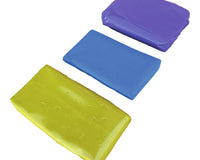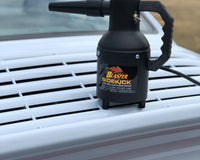Mould and mildew thrive in environments where moisture is present, and unfortunately, the interior of your car can often provide the ideal breeding ground. Whether it’s a forgotten water bottle spilled on the floor mat, a window left slightly open during rainfall, or just high humidity levels during the winter months, moisture can accumulate quickly. If not addressed promptly, even a small amount of dampness can become a haven for fungal growth. These infestations typically begin in hidden corners—beneath the carpet, under the seats, or in the boot lining—places you may not check regularly. And once mould takes root, it can spread rapidly across upholstery, headliners, and plastic surfaces.
Mildew is the lighter cousin of mould—often grey or white in appearance, and typically found on surfaces like seatbelts, headrests, or door panels. Mould, on the other hand, is usually green, black, or brown and carries a musty, unpleasant odour. Both can trigger allergic reactions and respiratory issues, especially in people with asthma or weakened immune systems. For this reason, mould in your car should never be ignored or just covered up with air fresheners. Aside from health implications, the presence of mould or mildew can decrease your car’s resale value, damage the interior materials, and cause ongoing odour problems.
Most people only notice mould or mildew once the smell becomes unbearable or visible patches appear. However, by the time you can see it, the infestation has likely already penetrated deeper layers. Early signs include persistent damp smells, foggy windows, and allergy-like symptoms while driving. It's important to act fast as soon as you suspect any issue. Proper knowledge of how mould forms and where it hides gives you a head start in eliminating it before it becomes a full-blown problem. Taking action early can save you time, money, and a great deal of hassle in the long run.
Health Risks Associated with Mould in Your Car
Many car owners underestimate the health risks posed by mould and mildew, brushing them off as minor inconveniences. In reality, they can contribute to a range of health problems, especially when left untreated over time. For some, especially young children or the elderly, exposure to mould spores can cause sneezing, coughing, or skin irritation. Others may experience more severe symptoms such as headaches, sinus congestion, wheezing, or chronic fatigue. If you're already susceptible to respiratory issues or have a weakened immune system, even a short car ride can become a hazard. Long-term exposure can lead to respiratory infections and even neurological symptoms in rare cases.
The air circulation system in your car can make matters worse. When mould spores are disturbed—either by your movement or air vents—they become airborne and circulate throughout the cabin. If your vehicle's air conditioning or heating system is contaminated, the problem intensifies. Every time you turn on the fan, you could be unknowingly releasing a fresh wave of spores into the air you breathe. Over time, this can compromise the air quality inside your vehicle, turning your daily commute into a health hazard. Passengers, particularly children and pets, may begin to exhibit signs of discomfort after just a few minutes inside.
Unfortunately, mould doesn't just stay on surfaces. It releases microscopic spores that embed themselves in porous materials like fabric seats, carpets, and ceiling liners. As the infestation deepens, it becomes harder to remove and easier to breathe in. Addressing it early not only helps maintain a clean, pleasant car interior, but also protects the health of everyone who rides in it. Ignoring mould is not only damaging to your car's interior—it's potentially dangerous for your wellbeing.
Common Causes of Interior Moisture Build-Up
Several everyday habits and unexpected occurrences can lead to the moisture build-up that allows mould to grow. One of the most common culprits is leaving windows or the sunroof slightly ajar, especially overnight or during rainstorms. Even a small opening can let in enough water to dampen your seats or floor mats. Another source is blocked or clogged drainage channels, particularly around your windscreen or under the car. When these become obstructed by leaves or debris, water accumulates and often seeps inside. The boot is particularly vulnerable if the seal around the lid is compromised, allowing rainwater to leak in unnoticed.
Flooding is an obvious but severe cause. If your car has been caught in a flood or driven through deep water, the interior can remain damp for days or even weeks. This prolonged exposure to moisture creates the perfect environment for mould spores to settle and grow. Similarly, condensation from wet clothes, umbrellas, or snow-covered boots can also contribute to long-term dampness. Winter months, in particular, increase the risk because windows fog up easily, and people tend to carry more moisture inside the vehicle unknowingly.
Another overlooked issue is leaky seals or damaged weather stripping. Over time, the rubber seals around windows, doors, and windscreens can degrade and allow water ingress. A spill from drinks or a leak from the heater core can also introduce moisture into the cabin. It's not just the initial water that's the problem—it’s what happens when it doesn't dry quickly. Poor ventilation, low temperatures, and dark corners create an environment where moisture lingers, making your vehicle an easy target for mould and mildew.
Tools and Products You'll Need for Mould Removal
Before you dive into cleaning, it’s crucial to gather the right tools and products to ensure a thorough and safe job. First, equip yourself with high-quality protective gear. This includes rubber gloves, a respirator or high-filtration face mask, and safety goggles to prevent contact with spores. Mould is not something you want to touch or breathe in, even in small quantities. Next, you’ll need a stiff-bristled brush to scrub affected areas and microfibre cloths for wiping and drying surfaces. These cloths should be discarded afterwards if they come into contact with mould to avoid cross-contamination.
As for cleaning products, there are several effective options. You can choose commercial mould removers designed specifically for automotive interiors, which are often safe for use on fabrics and plastics. Alternatively, natural solutions like a mix of white vinegar and water (typically in a 1:1 ratio) are surprisingly effective. Vinegar not only kills many strains of mould but also neutralises odours without the harshness of bleach. Baking soda can be added to neutralise smells and absorb excess moisture. If you opt for a chemical-based product, ensure it’s non-toxic and labelled as safe for use inside vehicles to avoid damaging interior finishes.

Don’t forget to keep a portable wet/dry vacuum handy. This can help remove excess water from carpets and upholstery during the drying process. A handheld steam cleaner can also be a great investment for deep-cleaning fabric seats and flooring, as it reaches high temperatures that kill spores. Finally, you’ll need an odour eliminator—preferably one designed to treat mould and mildew smells rather than just masking them. Products containing activated charcoal or ozone treatments can help remove persistent odours from the air and soft surfaces alike.
Step-by-Step Guide to Removing Mould and Mildew from Your Car
Step 1: Prepare Your Vehicle and Protect Yourself
-
Remove all loose items including mats, seat covers, and personal belongings.
-
Open all windows and doors to ventilate the space.
-
Wear gloves, a mask, and protective eyewear to avoid exposure to spores.
-
Park the car in a well-ventilated, sunny area to aid drying.
Step 2: Identify All Affected Areas
-
Carefully inspect seats, carpets, headliners, and boot liners for visible signs of mould.
-
Pay attention to corners and under-seat areas where moisture tends to collect.
-
Use your nose—mould gives off a distinct musty smell even if it’s not visible.
-
Check air vents and the HVAC system; mould here can be difficult to spot but dangerous if left untreated.
Step 3: Vacuum and Remove Loose Spores
-
Use a HEPA-filter vacuum or wet/dry vac to remove surface mould and debris.
-
Vacuum all seats, carpets, and fabric surfaces thoroughly.
-
Dispose of the vacuum bag or clean the canister immediately after use.
-
Avoid using a standard household vacuum as it may spread spores back into the air.
Step 4: Apply Your Cleaning Solution
-
Spray a mould-killing solution (vinegar mix or commercial cleaner) onto the affected areas.
-
Let the solution sit for 10 to 15 minutes to break down fungal roots.
-
For stubborn spots, use a brush to scrub in circular motions.
-
Avoid oversaturating fabrics as this can encourage further mould growth.
Step 5: Wipe, Rinse and Dry
-
Use microfibre cloths to wipe away the loosened mould.
-
If needed, rinse the area lightly with warm water and a damp cloth.
-
Use a wet/dry vacuum to extract any remaining moisture from seats and carpet.
-
Open windows and doors to allow fresh air to circulate and assist in drying.
Step 6: Neutralise Odours and Air Out
-
Use a dedicated odour eliminator spray or an ozone generator for a few hours.
-
Sprinkle baking soda on carpets and seats, let sit overnight, then vacuum thoroughly.
-
Leave the car in the sun for several hours to let UV rays kill lingering spores.
-
Replace cabin air filters if there’s any chance of mould contamination inside the ventilation system.
Step 7: Prevent Future Mould Growth
-
Fix any water leaks or compromised seals around doors and windows.
-
Regularly clean and air out the interior, especially during humid or rainy months.
-
Use moisture absorbers or silica gel packs inside the car to reduce humidity levels.
-
Consider running the heater or AC with the windows down for 10 minutes weekly to keep air circulating and vents dry.
Preventative Measures to Keep Your Car Mould-Free
Once you’ve dealt with the immediate infestation, prevention becomes your best line of defence. Start by ensuring your car stays as dry as possible, particularly during colder months or wet weather. Avoid leaving windows slightly open—even a small gap can introduce a significant amount of moisture overnight. After any spill or wet incident inside the car, act quickly. Blot the area dry, use a wet vacuum if necessary, and allow ample ventilation. Keeping your vehicle’s seals and weather stripping in good condition also goes a long way in preventing water ingress.
It’s also helpful to invest in moisture control products like dehumidifier bags or silica packs, which can be left under seats or in the boot. These are particularly useful in colder climates where condensation is more common. When parked for extended periods, consider leaving the windows slightly cracked open only if the car is under a dry, covered shelter. Avoid storing damp items inside, such as gym bags, towels, or wet clothes. These are easy to overlook but are major contributors to interior humidity.
Regular maintenance and cleaning also play a role in keeping mould at bay. Vacuum your carpets and upholstery frequently and wipe down hard surfaces to remove any organic matter where mould could take hold. Don’t forget to check less obvious areas like under floor mats and behind seat covers. By establishing a routine and being proactive, you can significantly reduce the chances of another outbreak. A clean, dry, and well-ventilated car interior is not only healthier but also more comfortable and pleasant to drive in.
Conclusion: Say Goodbye to Mould and Restore a Fresh Interior
Mould and mildew in your car are more than just cosmetic issues—they’re warnings of deeper problems. From health risks to structural damage, letting mould persist in your vehicle can have far-reaching consequences. Fortunately, with the right knowledge, tools, and approach, you can eliminate these fungal invaders and prevent them from coming back. Addressing the issue early, using proper protective gear, and following a step-by-step cleaning routine will ensure your vehicle remains a safe, fresh-smelling, and enjoyable space.
The key lies in consistency. A single deep-clean won’t protect your car forever, but regular inspections, moisture control, and simple habits like cracking windows in sunlight or running your AC periodically can keep things in check. If mould returns frequently, it’s worth investigating deeper causes like hidden leaks or HVAC issues. Don’t rely solely on air fresheners to mask the problem—tackle it head-on with proper products and preventative measures.
Your car is more than a means of transportation—it’s a space where you spend time, transport loved ones, and sometimes even eat or rest. Keeping it mould-free is not just about aesthetics but about safeguarding your comfort and wellbeing. With a little diligence and attention, you can ensure your vehicle’s interior stays as clean, safe, and inviting as the day you first drove it home.




